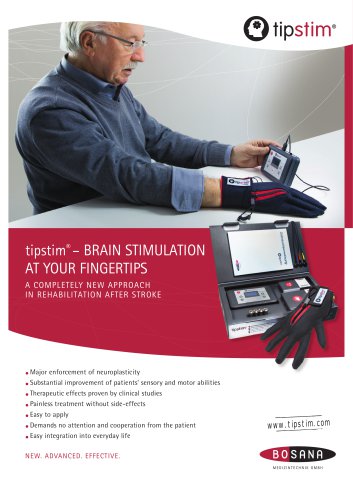
Tipstim® - Brainstimulation at your fingertips A completely new approach in rehabilitation after stroke
1 /
1Pages
Catalog excerpts

Tipstim® - Brainstimulation at your ngertips A completely new approach in rehabilitation after stroke Scientic background Generally, neuroplasticity-based rehabilitation utilizes task specic training and mass practice to drive plasticity processes and brain reorganization to restore behavior. However, afferent somatosensory information is not only crucial for tactile and haptic but also for motor performance. Conceivably, impaired sensory abilities further complicate motor function recovery. Therefore, the development of additional and alternative approaches that could supplement, enhance, or even replace conventional training procedures would be advantageous. Over many years, research at the Institute for Neuroinformatics at the Ruhr University Bochum explores the potentials and efcacy of passive sensory stimulation approaches as an alternative means to directly enforce neuro-plasticity mechanisms. Repetitive sensory stimulation in brain injury patients over weeks or longer improves persistently tactile perception and sensorimotor behavior. Delineation from peripheral stimulation methods A variety of different forms of so-called TENS or EMS procedures are in use to support muscular functions to improve motor behavior or to treat chronic pain. All these approaches have in common that they target periphery such as skin or skeletal muscles. In contrast, tip-stimulation with tipstim® employs sensory stimulation as a means to directly interfere with brain activity and local neuroplasticity mechanisms. In this sense, sensory stimulation is a vehicle to target directly brain processes for a locally specic induction of plastic reorganization. tipstim®-therapy is a common project of the Neural Plasticity Lab, Institute of Neuroinformatics, Ruhr University of Bochum, of the Neurological Clinic of the University Hospital Bergmannsheil in Bochum and of the companies Haynl Medizintechnik GmbH and BOSANA Medizintechnik GmbH. Sensory stimulation drives plastic processes in the brain areas activated by the stimulation. Because rehabilitation is based on such plastic processes, sensory stimulation allows targeted modication of brain processes and thus alteration of human behavior. Previous studies have shown that sensory stimulation in fact induces reorganization in and around those brain areas that became dysfunctional by stroke or other brain injuries. This reorganization will facilitate reactivation of cortical tissue that has preserved some functionality. The resulting remodeling of cortical circuits is then assumed to mediate behavioral recovery. From a medical point of view, the persistence of benecial effects, the ease of application and the broad range of behavioral improvements make sensory stimulation a prime candidate for intervention and rehabilitation in brain injury patients. More information on http://www.tipstim.com Reference study: Repetitive sensory stimulation for the treatment of sensorimotor decits in subacute stroke patients: a randomised, sham-controlled trial (JC Kattenstroth, T Kalisch, W Greulich, M Tegenthoff, HR Dinse), published 86th Congress of the German Society of Neurology, September 2013 Scientic studies for application-orientated medical innovation: Dinse HR, Kattenstroth JC, Gatica Tossi MA, Tegenthoff M, Kalisch K (2011) Sensory stimulation for augmenting perception, sensorimotor behaviour and cognition. In: Augmenting Cognition, Markram H, Segev I (eds). EPFL Press, pp 11-39 Kattenstroth JC, Kalisch T, Tegenthoff M, Dinse HR (2012) Long-term sensory stimulation therapy improves hand function and restores cortical responsiveness in patients with chronic cerebral lesions. Three single case studies. Front Hum Neurosci 6: 244 Dinse HR, Kattenstroth JC, Tegenthoff M, Kalisch T (2011) Plastizität, motorisches Lernen und sensible Stimulation. In: Motorische Therapie nach Schlaganfall. Dettmers C, Stephan KM (eds), Hippocampus Verlag, pp 17-43 Smith PS, Dinse HR, Kalisch T, Johnson M, Walker-Batson D (2009) Effects of repetitive electrical stimulation to treat sensory loss in persons poststroke. Arch Phys Med Rehabil 90: 2108-2111 Kalisch T, Tegenthoff M, Dinse HR (2009) Sensory stimulation therapy. Front Neurosci 3: 96-97 Preliminary work / basic principles: Dinse HR, Ragert P, Pleger B, Schwenkreis P, Tegenthoff M (2003) Pharmacological modulation of perceptual learning and associated cortical reorganization. Science 301: 91-94 Pleger B, Foerster AF, Ragert P, Dinse HR, Schwenkreis P, Nicolas V, Tegenthoff M (2003) Functional imaging of perceptual learning in human primary and secondary somatosensory cortex. Neuron 40: 643-653 Dinse HR, Kleibel N, Kalisch T, Ragert P, Wilimzig C, Tegenthoff M (2006) Tactile coactivation resets age-related decline of human tactile discrimination. Ann Neurol 60: 88-94
Open the catalog to page 1


